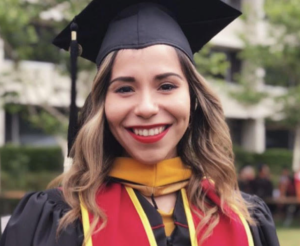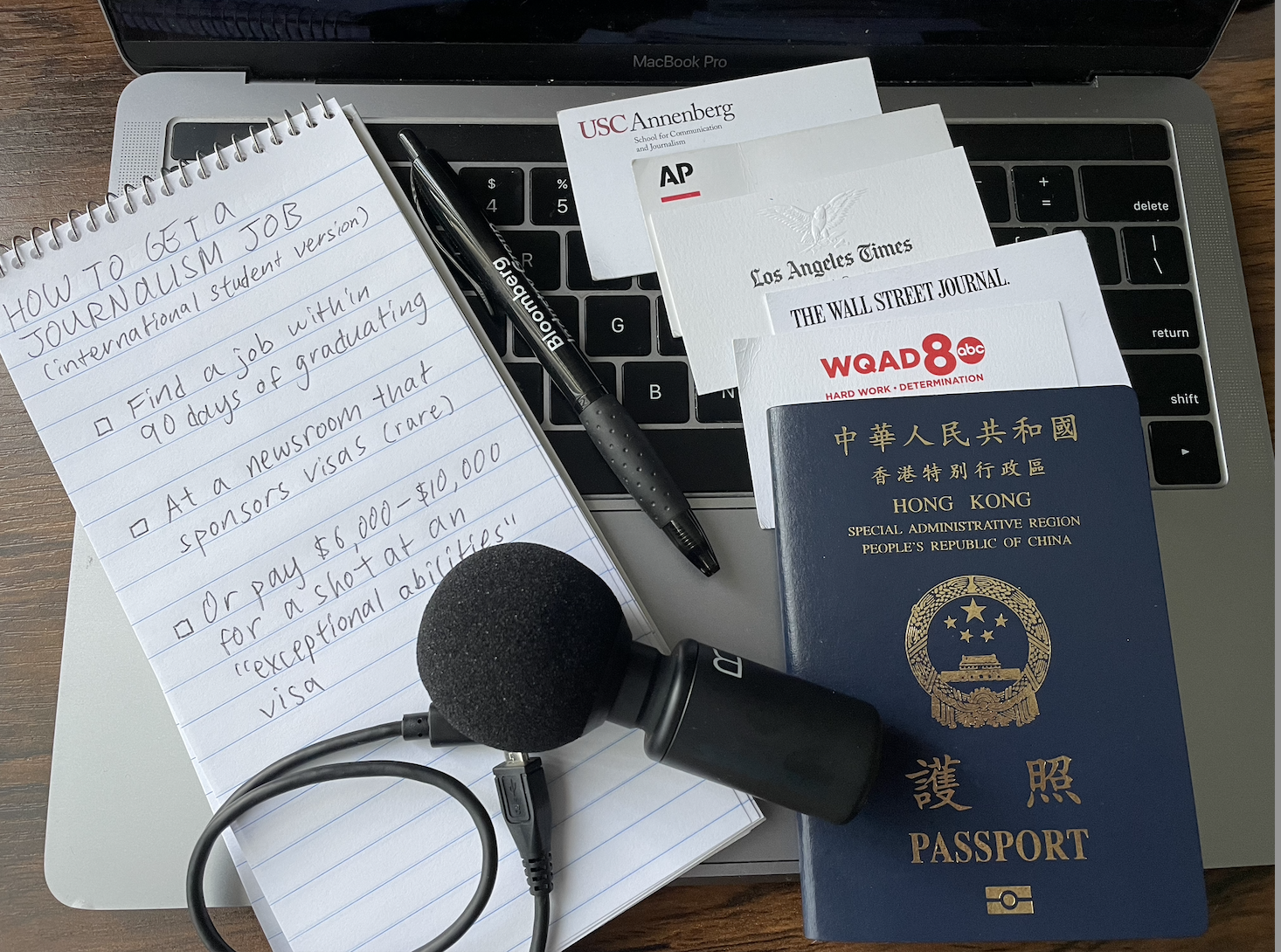Yanqi Xu has reported across all mediums. She has worked as a TV producer, social media intern, radio anchor and data reporter in internships, fellowships and jobs for Al Jazeera, Politifact, an NPR-affiliate radio station, nonprofit Investigative Reporters and Editors and more. And when Xu graduated in 2019 with a master’s degree in journalism from the University of Missouri-Columbia, she was going to become a data journalist.
Instead, she applied to more than 70 jobs over the next year and a half, most of which she never heard back from. Of those who did engage her, some stopped following up after learning about her need for a visa sponsorship.
“Sometimes the identity is so ingrained I don’t see myself as a person, I see myself as an international student who is disadvantaged,” she said.
Maybe if I were even more skilled they would take a chance on me, Xu thought. Unable to travel back home to China during the outbreak of COVID-19, and with her one-year post-graduation visa expiring, Xu took up a second master’s degree in data analytics.
After completing her second degree two years later, Xu was still faced with $10,000 in attorney and immigration fees for a shot at an O-1 “Alien of Extraordinary Ability” visa, which would allow her to stay and work in the U.S. for three more years.
Should it be this hard?
As newsrooms ramp up diversity initiatives and reexamine their hiring practices, recruiters continue to leave out international students pursuing journalism in the United States. They are graduates from prestigious programs who, like Xu, struggle to get hired or have job offers rescinded due to their foreign status.
Upon graduation, international students may apply for Optional Practical Training (OPT), a permit that allows them to work in the U.S. for up to a year, or three years if their degree is a STEM-designated program. Students who want to stay beyond that must go back to school or switch to another work visa, which in most cases is either the H1-B, which uses a lottery system, or the O-1. However, many newsrooms refuse to sponsor any visas due to paperwork, high fees and unpredictable wait times.
“You are investing in someone who’s going to be a permanent employee,” said Theodore Kim, director of career programs at The New York Times. “So typically, if you are sponsoring someone, it is someone who is at the very top of their field.”
Elizabeth Mayoral Corpus graduated with a master’s in journalism from the University of Southern California in 2019. Mayoral Corpus dreamed of working as a TV reporter in America — it’s dangerous to do journalism back home in Mexico, especially as a woman. She soon learned how impossible it would be to land even an entry-level position.
“I remember recruiters were really excited to interview me for jobs, but once they asked me if I needed sponsorship, there my interview stopped,” she said. “They’d say, ‘You’re amazing and your professors have recommended you so much, but we can’t do anything. Good luck.’ ”
Mayoral Corpus recalls how other times, job applications would abruptly end during the electronic screening stage with a “Thank you for applying” after she checked the “Yes” box in response to whether she might need sponsorship in the future. “They didn’t even have a chance to know who I was.”
Other international students, such as Xinyan Fu, who graduated from Emerson College in 2022 with a bachelor’s degree in journalism, have said they’ve had to go to great lengths to navigate around the tricky work sponsorship question.
“Some of my friends have suggested (I) swap my Chinese name to my English name so people will at least give me a first interview,” she said.
The few job offers Mayoral Corpus did get that summer, including a dream gig as a digital producer for a TV station in Texas co-owned by CBS and Telemundo, would never be realized. She had to turn them all down because U.S. immigration took half a year to process her OPT work authorization. International students typically wait an average of three to five months for immigration to process their OPT, though students aren’t allowed to work and it’s very risky for them to leave the country during the interim. As a result, Mayoral Corpus had to stay with friends as she was applying to jobs throughout the summer and turn down opportunities she would have gotten had she not been waiting for her visa.

USC grad Elizabeth Mayoral Corpus
“I had amazing professors in USC and they had a lot of faith in me and hope in me. They told me, ‘You’re going to be such a great reporter, we have so much expectations on you.’ And I felt so frustrated because I graduated with no opportunities,” she said. “Nobody wanted to hire me because of (the visa).”
“I feel like a failure to all of them.”
Securing the initial one-year work authorization, however, solves only half the problem. When they are applying for an OPT in the spring, international students must put down what date they want their work authorization to start within 60 days after they graduate. It’s essentially a guessing game: Putting a start date that’s too late could bar students from accepting early offers as they cannot work yet, but putting a start date that’s too soon, before opportunities have surfaced, could cut into their unemployment time.
Fresh grads on OPT cannot be unemployed for more than 90 days cumulative. It’s a tremendous stressor in a relatively unstable industry characterized by short-term contracts and frequent layoffs.
Grace Gao applied to around 200 jobs after graduating with a master’s in journalism at USC in May 2022. Her OPT allowed her to start working in July, though she couldn’t find a job that was not on a short-term contract basis within three stressful months. And so she was forced to leave for home, effectively ending her dream of staying in the U.S. as a reporter.
“It wasn’t worth it for me to stay in the States and worry about my visa every single day,” said Gao, who moved twice after she graduated as she was uncertain when she would have to relocate next.
The day she landed in China, the American newsroom she had hoped to join emailed her to tell her she made it off their waitlist and extended an offer. It was too late.
As for Mayoral Corpus, she now commutes up to 90 minutes daily across the U.S.-Mexico border to report for a local American newspaper. She is currently on a nonimmigrant visa exclusive to Canadian and Mexican professionals, but those who don’t come from those countries must rely mainly on just two other ways to stay in the U.S. after their OPT expires.
The most common one is the H1-B visa, a system for employers to sponsor foreign employees to work in the States for a few years. But many newsrooms, including The New York Times and the Los Angeles Times, explicitly state they will not sponsor new visas for applicants to their prestigious fellowships. Journalism job applications typically do not mention citizenship or sponsorship requirements.
A 2019 analysis done by Ruby Yuan as his senior capstone project at USC Annenberg showed that the majority of U.S. media organizations have filed 10 or fewer H1-B visa sponsorships for journalism-related jobs in the past three years. The low rates may be due to the fact that even after a company pays and files the paperwork to sponsor an employee, the employee is subject to a lottery system that makes their chances of getting to stay uncertain. In contrast, tech and business companies such as Google and McKinsey file thousands of sponsorships every year.
“The sponsorship process can take many months, and our fellowship is only for a year,” said Kim, who noticed visa questions have become tougher over the years. “That’s to say nothing of the cost of sponsorship, which can be in excess of $10,000 dollars,” he adds. “Every year we’re bringing in 30-35 fellows. It’s cost prohibitive.”
The other alternative for international students is to apply for an exceptional abilities visa. If granted, the visa would allow applicants to stay in the U.S. for three years, circumventing the uncertainty of the H1-B lottery. It’s the same visa that Justin Bieber and Nobel laureates are on, and the one Xu paid for to stay in the country. Fees to attorneys and immigration can range from $6,000 to $10,000.
If it’s hard in print journalism, it’s nearly impossible in broadcast. After she graduated from USC in 2019, Dongyao Nie reached the final round of interviews at a few major TV news networks, only to be told that they have a hard “no” policy for sponsorship when she finally brought up the matter.
She has a theory about why: “Broadcast is already so competitive, so why would they need a foreigner?”
Nie eventually managed to land a job at Al Jazeera as a researcher but left after realizing there was zero path for career advancement as a contract employee who could be terminated at short notice. She left the U.S. to anchor for a major news network in Hong Kong.
“It’s kind of discriminatory — you’re open to any race, sexual orientation, but why not a foreigner?” she said. “We’re not inferior to anybody just because we need a visa sponsorship. We’re really diligent and responsible, and we can bring you different perspectives to local reporting.”
Even those who have secured a job could have their offer rescinded due to their visa status. This worst-case scenario was the reality for at least three other international students interviewed hoping to be journalists in the U.S. Bulbul Rajagopal, who graduated from USC in 2020, was hired by one of the largest daily newspapers in the nation, but her offer was rescinded because they decided not to sponsor her visa.
“You know what? I was good enough to get hired. The offer got rescinded because of the visa, not because I wasn’t good enough. It gave me the extra push to keep on applying,” Rajagopal said. She added that she wished newsrooms were more upfront and transparent about their hiring policies for non-U.S. citizens in need of sponsorship. The good news is that the local newspaper in California where she now works is sponsoring her, and even covered a portion of her visa fees.
Degree programs have also failed to prepare students for the realities of being an international student pursuing journalism in the U.S., said Gao, who thinks colleges should be upfront about expectations and job prospects – and prepare international students for future legal hurdles – before they enter the program.
“I didn’t know until a recruiter told me two months before I graduated, which is already too late for me to build up my portfolio in visual storytelling,” said Gao. Had she known, she would have pursued something more technical such as data visualization in a STEM-certified program. In recent years, some journalism degrees, such as ones from Northwestern University and New York University, have attained STEM certification.
Rajagopal argues that more newsrooms should consider hiring international students because of their cultural diversity, language skills and the living experiences and perspectives that come from being raised in another country. These are qualities that give their reporting great depth, she says.
“Everyone talks about America being a melting pot. But if that’s the case, newsrooms should reflect that,” Rajagopal said. “So many people came from so many different countries, and American journalism can stand to have that as well.”
“There is a bit of a financial strain, but it’s worth it,” Rajagopal added. “International students will pay you back in dividends in the work they do.”







